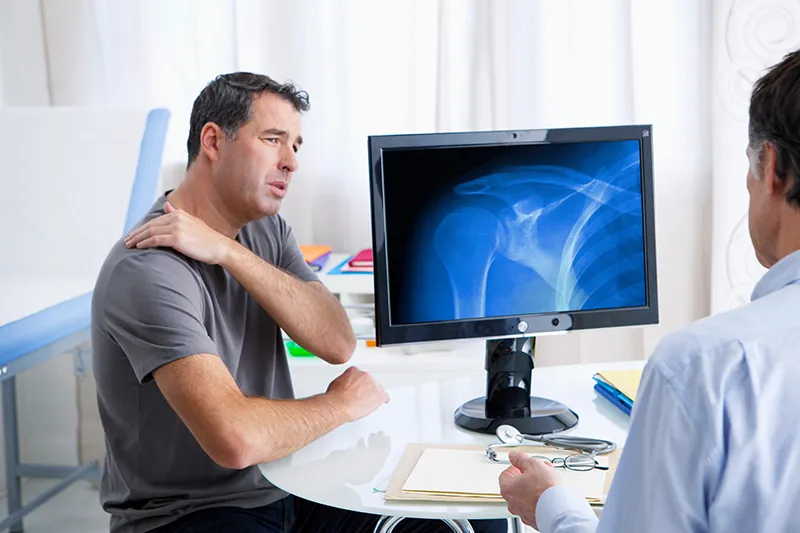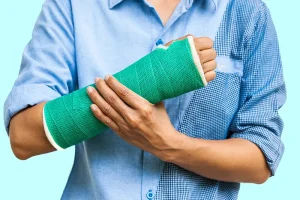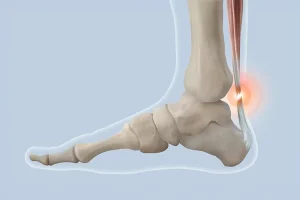Acromioclavicular Joint Dislocation
Shoulder Arthroscopy Treatment
Home » Orthopedic Surgery » Acromioclavicular joint dislocation
Conditions Treated

Acromioclavicular joint dislocation is a common shoulder injury, usually caused by direct trauma. If you have suffered a blow to the shoulder and are experiencing pain, swelling, or difficulty moving, you may have this injury.
Find out what it means, how it is treated, and what steps to take for an effective recovery.
Book an Appointment
What is acromioclavicular joint dislocation?
Acromioclavicular joint dislocation is a medical condition involving a separation or dislocation of the acromioclavicular joint, located between the acromion (part of the shoulder blade) and the lateral end of the clavicle.
Anatomy of the acromioclavicular joint
The acromioclavicular joint is a small but essential joint in the complex movements of the shoulder. It is stabilized by the acromioclavicular and coracoclavicular ligaments. Any severe trauma can lead to stretching or tearing of these ligaments, causing a dislocation.

Time is crucial from the moment of the accident
Treatment is most effective in the first 7-10 days after the injury, because after this period the chances of success begin to decrease.
Chronic dislocations (untreated for a long time) require more complex procedures and have a longer recovery time.
Proper treatment restores the stability, function, and normal appearance of the shoulder.
Classification of acromioclavicular dislocation
There are six degrees of dislocation, according to Rockwood’s classification:
- Grade 1 acromioclavicular dislocation: ligament strain;
- Grade 2 acromioclavicular dislocation: partial ligament rupture;
- Grade 3 acromioclavicular dislocation: complete rupture with visible displacement;
- Grade 4-6 acromioclavicular dislocation: severe displacement, directed posteriorly or superiorly.
Surgery is particularly recommended for grades 4 and 6.

Types of treatment Surgical – Shoulder arthroscopy
Treatment for acromioclavicular dislocation varies depending on the severity of the injury and the time elapsed since the trauma. It is important to distinguish between repair and reconstruction:
Repair (within the first 2 weeks)
Repair is recommended when the procedure takes place within the first 7-10 days, maximum 2 weeks, after the accident. In this acute phase, the chances of success are higher and the technique is simpler.
- The most commonly used method is direct fixation with TightRope systems, performed using a classic approach.
Note: After 7-10 days, the effectiveness of the treatment gradually decreases.
Reconstruction (after 2 weeks)
If the patient presents late, treatment requires reconstruction of the coracoclavicular ligament complex, a more complex procedure.
This is ideally performed using a combination of arthroscopy and conventional surgery.
It requires the use of a ligament graft (biological or artificial).
Symptoms
- Intense pain in the shoulder, especially when moving;
- Visible swelling or deformation (in more severe cases, the collarbone may protrude);
- Reduced shoulder mobility;
- Sensitivity to touch.
Recovery from acromioclavicular joint separation
- Immobilization: 3-4 weeks in a brace;
- Physical therapy: begins gradually after 4 weeks;
- Full recovery: 3-6 months depending on severity and patient compliance.
Competitive athletes can return to training after approximately 4-5 months.
Risks and complications
Like any surgery, shoulder arthroscopy involves risks:
- Infection;
- Joint stiffness;
- Failure of ligament fixation;
- Persistent pain or instability.
However, when performed by an experienced specialist, the risks are minimal.
Why choose VenArt Clinic?
- You have access to a team of specialists with extensive experience in minimally invasive surgery.
- You benefit from a quick recovery thanks to the modern techniques we use.
- You receive personalized care from a dedicated team, ready to offer you the best solutions for your health.
If you need more information or would like to schedule a consultation, please do not hesitate to contact us.
Schedule an appointment
If you have suffered a shoulder injury or suspect an acromioclavicular dislocation, schedule a specialist consultation now. The sooner you act, the better your chances of a full recovery.
Medical Team
Frequently Asked Questions
What symptoms appear?
Pain in the shoulder area, swelling, tenderness, and sometimes visible deformity.
How is the diagnosis made?
Through clinical examination and confirmation with X-ray.
Are there several degrees of disjunction?
Yes, there are six degrees, depending on the severity of the rupture.
Is it always treated surgically?
No, only serious or unstable cases require surgery.
How long does recovery take?
It depends on the degree of disjunction, but it can take anywhere from a few weeks to a few months.
Can I play sports after recovery?
Yes, but only after the shoulder is completely healed and with the doctor’s approval.
Is the pain constant?
Not necessarily, but it may persist if left untreated or if recovery is incomplete.
What role does physical therapy play?
It is essential for restoring mobility and preventing complications.








